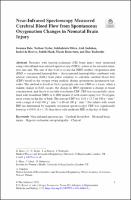Chapter Near-Infrared Spectroscopy Measured Cerebral Blood Flow from Spontaneous Oxygenation Changes in Neonatal Brain Injury
Author(s)
Bale, Gemma
Taylor, Nathan
Mitra, Subhabrata
Sudakou, Aleh
Roever, Isabel de
Meek, Judith
Robertson, Nicola
Tachtsidis, Ilias
Collection
WellcomeLanguage
EnglishAbstract
Neonates with hypoxic-ischaemic (HI) brain injury were monitored
using a broadband near-infrared spectroscopy (NIRS) system in the neonatal intensive
care unit. The aim of this work is to use the NIRS cerebral oxygenation data
(HbD = oxygenated-haemoglobin
– deoxygenated-haemoglobin) combined with
arterial saturation (SaO2) from pulse oximetry to calculate cerebral blood flow
(CBF) based on the oxygen swing method, during spontaneous desaturation episodes.
The method is based on Fick’s principle and uses HbD as a tracer; when a
sudden change in SaO2 occurs, the change in HbD represents a change in tracer
concentration, and thus it is possible to estimate CBF. CBF was successfully calculated
with broadband NIRS in 11 HIE infants (3 with severe injury) for 70 oxygenation
events on the day of birth. The average CBF was 18.0 ± 12.7 ml 100 g−1 min−1
with a range of 4 ml 100 g−1 min−1 to 60 ml 100 g−1 min−1. For infants with severe
HIE (as determined by magnetic resonance spectroscopy) CBF was significantly
lower (p = 0.038, d = 1.35) than those with moderate HIE on the day of birth.


 Download
Download